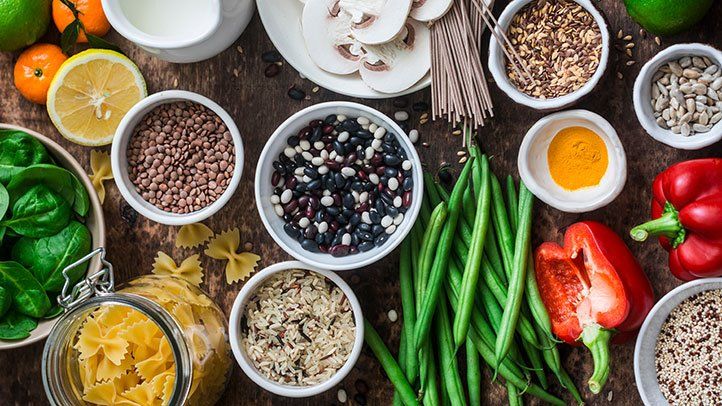
Inflammation can be reduced by eating lots of fruits and vegetables. You should eat at least nine servings of these foods each day. Fresh fruits should be eaten, especially those that are high in antioxidants (such as strawberries). Whole grains are important, but rice noodles should be limited to only a few times per week. Avoid baking flour, as this does not constitute an anti-inflammatory diet. These foods make you more energetic and help to prevent inflammation.
When choosing a diet that promotes good health, try to eat a diet rich in green leafy vegetables. This will increase the intakes of omega-3 fatty acid and fight inflammation. Alternative options include organic meats, and dairy products. Also, consider omega flax oil and fish oil for dietary fats. For hydration, make sure to drink eight glasses of water every day.
Another way to reduce inflammation is to eat whole foods. You should eat foods that contain no added sugar. Vegetables and fruits are best. You can eat low-fat dairy products, fruits and vegetables, nuts, seeds and olive oil for a healthy lifestyle. Your food can be enhanced with spices and herbs. Your body could be reduced by adding vitamin E and antioxidants.

There is no cure for inflammation. However, there are things you can do to lower your chances of developing it. A healthy diet should contain plenty of fresh fruits & vegetables. You should also avoid processed foods, sugary foods, and other junk foods. Also, it is important to include some coconut oil and fatty seafood in your diet. You'll be healthier, and less susceptible to inflammation, if you eat these foods. If you want to have more anti-inflammatory foods in your diet, you can check out EverlyWell's vitamin D and high sensitivity CRP test kit.
Although there are no scientific studies to support this particular argument, there is strong evidence to suggest that reducing inflammation is a good idea in many cases. It can prevent the development of chronic diseases like cancer or heart disease. Inflammation happens naturally in our bodies. It is a normal, healthy response that protects us from harm. Changes in diet can help to reduce inflammation. The following guidelines can help reduce the risk of chronic disease.
Your health is directly affected by the foods you eat. Quercetin, which blocks the production of histamines in onions, is rich in quercetin. Anthocyanins, which are found in berries, help to reduce inflammation. Even though this isn’t an antiinflammatory diet, you can opt for foods high in flavones as well as other anti-inflammatory ingredients. A variety of whole grains as well as berries should be included in your diet.
There are many reasons for inflammation. Chronic inflammation is caused by many factors including excess weight, poor sleep and pollution. Drinking a balanced diet with plenty of water and anti-inflammatory foods will help reduce your risk for chronic inflammation. You should eat healthy food to maintain your health. It is important to include anti-inflammatory ingredients in your diet. This will ensure that your body functions normally.

There are many reasons why inflammation can occur in the body. Inflammation can cause chronic pain, ear infections and even cancer if your body isn't used to it. Consuming foods high in polyphenols like blueberries and leafy vegetables is the best way to reduce inflammation. You may also benefit from the anti-inflammatory properties of coffee, which can help to protect your health. It is possible to improve your diet and get enough sleep.
Chronic inflammation is often caused by chronic inflammation. Many people suffer from chronic health problems due to their diet. Inflammation is a normal response to injury. However, it can also cause a variety of health problems. Inflammation can be caused by consuming a lot of refined carbohydrates. Certain foods, like soda, can cause harm to the body. They can cause fatigue, joint pain, and other symptoms. They can also promote the development of cancer and cardiovascular diseases.
FAQ
How do I count calories?
It is possible to wonder "What diet is best for me?" or "is counting calories necessary?" This depends on your health and lifestyle.
The Best Diet for Me - Which One is Right For You?
My current health status, personal goals, preferences, and overall lifestyle all play a role in choosing the right diet. There are many options, both good and bad. Some diets work for some people, while others are not. So what should I do? How can I make the best decision?
These are the main questions addressed by this article. It begins by briefly describing the various diets available today. After that, you will learn about the pros and disadvantages of each type. Finally, we'll look into how to choose the best one for you.
Let's first take a look at different diets.
Diet Types
There are three main types: low-fat, high-protein, or ketogenic. Let's take a look at them all below.
Low Fat Diets
A low-fat diet reduces the amount of fats you eat. This is done through reducing the intake of saturated fats (butter, cream cheese, etc.) and replacing them with unsaturated fats (olive oil, avocados, etc.). Low fat diets are often recommended to those who wish to lose weight quickly. This kind of diet could cause problems like constipation or heartburn and indigestion. A person may also experience vitamin deficiencies if they don't get enough vitamins.
High Protein Diets
High protein diets discourage carbohydrates and encourage the use of proteins. These diets are more protein-rich than others. They are meant to help build muscle mass and burn more calories. Unfortunately, they can't provide adequate nutrition for those who eat regularly. They are also very restrictive, so they might not be appropriate for everyone.
Ketogenic Diets
Also known as keto diets, ketogenic diets are also called keto diets. They are high fat and moderately carbohydrate and protein-rich. They are typically used by athletes and bodybuilders because they allow them to train harder and longer without getting tired. But, they require strict adherence to avoid negative side effects like nausea, headaches, and fatigue.
What is the best way to live a healthy lifestyle?
Healthy lifestyles include eating healthy food, regular exercise, good sleep, and avoiding stress. These are the keys to a healthy and long-lasting life.
You can start by making small changes in your diet and exercise routine. If you're looking to lose weight, walk for 30 minutes each morning. Swimming or dancing are great options if your goal is to become more active. You can also sign up for an online fitness program, such as Strava and Fitbit. This will track your activity.
Why does weight change as we age?
How can you tell if your bodyweight has changed?
Weight loss occurs when there is less fat than muscle mass. This means that calories must be consumed at a rate greater than energy. Activity levels are the most common reason for weight loss. Others include pregnancy, hormonal imbalances or certain medications. Weight gain occurs when there is more fat than muscle mass. It occurs when people consume more calories each day than they use. It can be caused by overeating or increased physical activity as well hormonal changes.
Our bodies lose weight because we eat fewer calories than we burn. By exercising regularly, our metabolism rates increase which in turn burns more calories during the day. But, this does not mean that we will be thinner. It is important to know if we are losing weight or gaining muscle. If we're burning more calories that we consume, we'll lose weight. However, if we consume more calories than we burn, we end up storing them as extra fat.
As we get older, our movement speed slows down and so we move less. We also tend to consume less food than when we were younger. Therefore, we tend to put on weight. On the other hand, we have more muscle mass and look larger than we actually are.
Without regularly weighing yourself, it is impossible to gauge how much weight you have lost. There are many ways to determine your weight. You can check your waist size, your hips, your thighs, your arms, etc. Some people prefer to use bathroom scales while others like to use tape measures.
To track your progress, weigh yourself once a week. Measure your waistline once per month. To track your progress, you can also take photos every few months of yourself to see how far it has come.
Online, you can find out your height and weight. If you're tall at 5'10", and weigh 180lbs, your weight would be 180.
Statistics
- This article received 11 testimonials and 86% of readers who voted found it helpful, earning it our reader-approved status. (wikihow.com)
- According to the 2020 Dietary Guidelines for Americans, a balanced diet high in fruits and vegetables, lean protein, low-fat dairy and whole grains is needed for optimal energy. (mayoclinichealthsystem.org)
- The Dietary Guidelines for Americans recommend keeping added sugar intake below 10% of your daily calorie intake, while the World Health Organization recommends slashing added sugars to 5% or less of your daily calories for optimal health (59Trusted (healthline.com)
- WHO recommends reducing saturated fats to less than 10% of total energy intake; reducing trans-fats to less than 1% of total energy intake; and replacing both saturated fats and trans-fats to unsaturated fats. (who.int)
External Links
How To
What does the term "vitamins" mean?
Vitamins are organic compounds found naturally in food. Vitamins are necessary for us to absorb nutrients in the foods we consume. Vitamins cannot come from the body so food must provide them.
There are two types if vitamins: water soluble, and fat soluble. Water soluble vitamins dissolve easily in water. These include vitamin C (thiamine), Vitamin B1 (riboflavin), Vitamin B2 (riboflavin), Vitamin B3 (niacin), Vitamin B6 (pyridoxine), Vitamin C, B1 (thiamine), Vitamin B2 (riboflavin), Vitamin B3 (niacin), and Vitamin B6 (pyridoxine). Fat soluble vitamins are stored in the liver and fatty tissue. These include vitamin D, E and K, as well as beta carotene.
Vitamins are classified based on their biological activity. There are eight main groups of vitamins.
-
A - vital for healthy growth.
-
C - essential for nerve function and energy generation.
-
D - necessary for healthy bones and teeth.
-
E - needed for good vision and reproduction.
-
K – Required for healthy nerves & muscles.
-
P - Essential for strong bones and teeth.
-
Q - aids digestion and absorption of iron.
-
R – Required for the formation of red blood vessels.
The recommended daily allowance for vitamins (RDA) varies based on gender, age, and physical conditions. The U.S. Food and Drug Administration has established the RDA values.
For adults aged 19 and older, the RDA for vitamin B is 400 micrograms daily. Because it is essential for the development of the fetus, pregnant women should consume 600 micrograms per daily. Children ages 1-8 require 900 micrograms per day. Infants under one year of age require 700 micrograms per day, but this amount decreases to 500 micrograms per day between 9 months and 12 months of age.
Children between the ages 1--18 years old who are overweight or obese require 800 micrograms per Day, while those who are overweight or obese need 1000 micrograms. To meet their nutritional needs, children underweight and obese require 1200 micrograms a day.
Children aged 4-8 years old who have been diagnosed as having anemia require 2200 micrograms of vitamin C per day.
2000 micrograms are required daily for good health in adults over 50. Breastfeeding or pregnant women require 3000 micrograms per daily due to higher nutrient demands.
Adults over 70 require 1500 micrograms each day, since they lose around 10% of their muscle mass every decade.
Women who are pregnant and lactating need more nutrients than the RDA. Pregnant and breastfeeding women require 4000 micrograms each day during pregnancy and 2500 Micrograms each day after delivery. Breastfeeding mothers need 5000 mg per day when breastmilk is being produced.